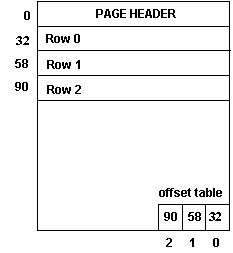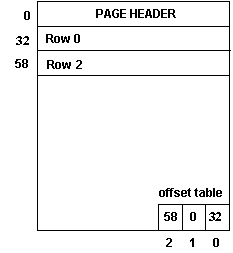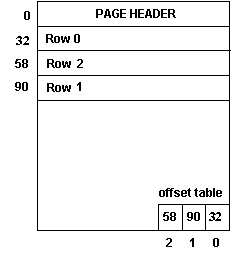General concepts
There are five kinds of pages in MS SQL 6.5:
- Data pages
- Index pages
- Allocation pages
- Text/Image pages
- Distribution pages
In this article I want to tell you about data page structure in MS SQL 6.5. The size of the data page in MS SQL 6.5 is 2Kb, i.e. 2048 bytes. Every data page consists of three part:
- 32 bytes header
- data rows
- offset table
See Figure 1:

Figure 1. General data page structure
This is the description of the page header:
- pageno
- is a logical page number
- nextpg
- next logical page number
- prevpg
- previous logical page number
- objid
- id of the table
- timestamp
- internal identifier
- nextrno
- next row number, that will be written on this page
- level
- the index level
- indid
- id of the index
- freeoff
- pointer to the free space at the end of the page
- minlen
- minimum rows length for this data page
Offset table contains two bytes for each row on the data page. MS SQL 6.5 uses the offset table to find the address of row. Every cell of the offset table contains the address of the row on the data page.
When you delete record, MS SQL 6.5 writes in the appropriate cell the zero value, deletes row, moves other rows to avoid free space between them and sets the new value into freeoff field of the page header. All rows are stored continuously on the data page.
When you insert new record, MS SQL 6.5 scans the offset table from the end. If there is cell with zero value in it, then offset of the new row will be inserted into this cell. If there is no cell with zero values in it, then new cell will be added in the offset table, new value will be written into freeoff field of the page header and the nextrno field of the page header will be increased by 1.
You can use the following command to view the data page structure (this command is not very good documented in SQL Server Books Online):
DBCC PAGE ({dbid|dbname}, pagenum [,print option] [,cache] [,logical])
PARAMETERS:
- Dbid or dbname
- Enter either the dbid or the name of the database in question.
- Pagenum
- Enter the page number of the SQL Server page that is to be examined.
- Print option
- (Optional) Print option can be either 0, 1, or 2.
0 - (Default) This option causes DBCC PAGE to print out only the page header information.
1 - This option causes DBCC PAGE to print out the page header information, each row of information from the page, and the page's offset table. Each of the rows printed out will be separated from each other.
2 - This option is the same as option 1, except it prints the page rows as a single block of information rather than separating the individual rows. The offset and header will also be displayed.
- Cache
- (Optional) This parameter allows either a 1 or a 0 to be entered.
0 - This option causes DBCC PAGE to retrieve the page number from disk rather than checking to see if it is in cache.
1 - (Default) This option takes the page from cache if it is in cache rather than getting it from disk only.
- Logical
- (Optional) This parameter is for use if the page number that is to be retrieved is a virtual page rather then a logical page. It can be either 0 or 1.
0 - If the page is to be a virtual page number.
1 - (Default) If the page is the logical page number.
Examples
In this examples I also use trace flag 3604. Trace flag 3604 sends trace output to the client. This trace flag is used only when setting trace flags with DBCC TRACEON and DBCC TRACEOFF.
Discounts data page structure
In this example one data page is output from the table discounts, database pubs.
USE pubs
GO
DBCC TRACEON (3604)
GO
DECLARE @pgid int
SELECT @pgid = first FROM sysindexes WHERE id = object_id('discounts')
DBCC PAGE (pubs, @pgid, 1)
GO
This is the result from my computer:
PAGE:
Page found in cache.
BUFFER:
Buffer header for buffer 0xf96580
page=0x1181000 bdnew=0xf96580 bdold=0xf96580 bhash=0x0
bnew=0xf964c0
bold=0xf96640 bvirtpg=2540 bdbid=5 bpinproc=0 bkeep=0 bspid=0
bstat=0x1004 bpageno=488
PAGE HEADER:
Page header for page 0x1181000
pageno=488 nextpg=0 prevpg=0 objid=544004969 timestamp=0001 0000486a
nextrno=3 level=0 indid=0 freeoff=122 minlen=5
page status bits: 0x100,0x1
DATA:
Offset 32 -
01181020: 0100017e 041a0049 6e697469 616c2043 ...~...Initial C
01181030: 7573746f 6d657202 1707 ustomer...
Offset 58 -
0118103a: 0401019e 02200056 6f6c756d 65204469 ..... .Volume Di
0118104a: 73636f75 6e746400 e803051a 18161607 scountd.........
Offset 90 -
0118105a: 020201f4 01200043 7573746f 6d657220 ..... .Customer
0118106a: 44697363 6f756e74 38303432 031c1807 Discount8042....
OFFSET TABLE:
Row - Offset
2 (0x2) - 90 (0x5a), 1 (0x1) - 58 (0x3a),
0 (0x0) - 32 (0x20),
See Figure 2:

Figure 2. Discounts data page structure
After delete
When you delete record, MS SQL 6.5 writes in the appropriate cell the zero value, deletes row, moves other rows to avoid free space between them and sets the new value into freeoff field of the page header. All rows are stored continuously on the data page.
DELETE FROM discounts WHERE discounttype = 'Volume Discount'
This is the result from my computer:
PAGE:
Page found in cache.
BUFFER:
Buffer header for buffer 0xf96580
page=0x1181000 bdnew=0xf5a448 bdold=0xf5a448 bhash=0x0
bnew=0xf964c0
bold=0xf96640 bvirtpg=2540 bdbid=5 bpinproc=7 bkeep=0 bspid=0
bstat=0x1004 bpageno=488
PAGE HEADER:
Page header for page 0x1181000
pageno=488 nextpg=0 prevpg=0 objid=544004969 timestamp=0001 0000519c
nextrno=3 level=0 indid=0 freeoff=90 minlen=5
page status bits: 0x100,0x10,0x1
DATA:
Offset 32 -
01181020: 0100017e 041a0049 6e697469 616c2043 ...~...Initial C
01181030: 7573746f 6d657202 1707 ustomer...
Offset 58 -
0118103a: 020201f4 01200043 7573746f 6d657220 ..... .Customer
0118104a: 44697363 6f756e74 38303432 031c1807 Discount8042....
OFFSET TABLE:
Row - Offset
2 (0x2) - 58 (0x3a), 1 (0x1) - 0 (0x0),
0 (0x0) - 32 (0x20),
See Figure 3:

Figure 3. After delete
After insert
When you insert new record, MS SQL 6.5 scans the offset table from the end. If there is cell with zero value in it, then offset of the new row will be inserted into this cell. If there is no cell with zero values in it, then new cell will be added in the offset table, new value will be written into freeoff field of the page header and the nextrno field of the page header will be increased by 1.
insert discounts values('Volume Discount', NULL, 100, 1000, 6.7)
This is the result from my computer:
PAGE:
Page found in cache.
BUFFER:
Buffer header for buffer 0xf96580
page=0x1181000 bdnew=0xf5a448 bdold=0xf5a448 bhash=0x0
bnew=0xf964c0
bold=0xf96640 bvirtpg=2540 bdbid=5 bpinproc=8 bkeep=0 bspid=0
bstat=0x1004 bpageno=488
PAGE HEADER:
Page header for page 0x1181000
pageno=488 nextpg=0 prevpg=0 objid=544004969 timestamp=0001 0000519e
nextrno=3 level=0 indid=0 freeoff=122 minlen=5
page status bits: 0x100,0x10,0x1
DATA:
Offset 32 -
01181020: 0100017e 041a0049 6e697469 616c2043 ...~...Initial C
01181030: 7573746f 6d657202 1707 ustomer...
Offset 58 -
0118103a: 020201f4 01200043 7573746f 6d657220 ..... .Customer
0118104a: 44697363 6f756e74 38303432 031c1807 Discount8042....
Offset 90 -
0118105a: 0401019e 02200056 6f6c756d 65204469 ..... .Volume Di
0118106a: 73636f75 6e746400 e803051a 18161607 scountd.........
OFFSET TABLE:
Row - Offset
2 (0x2) - 58 (0x3a), 1 (0x1) - 90 (0x5a),
0 (0x0) - 32 (0x20),
See Figure 4:

Figure 4. After insert
Literature
- SQL Server Books Online.
- INFO: Description of DBCC PAGE Command http://support.microsoft.com/support/kb/articles/Q83/0/65.ASP

